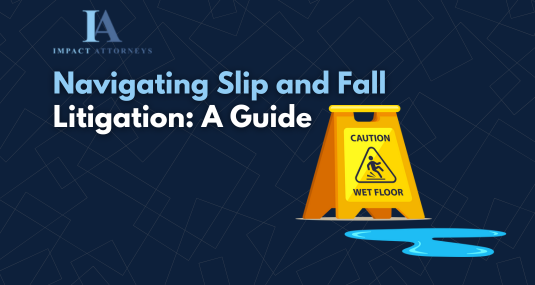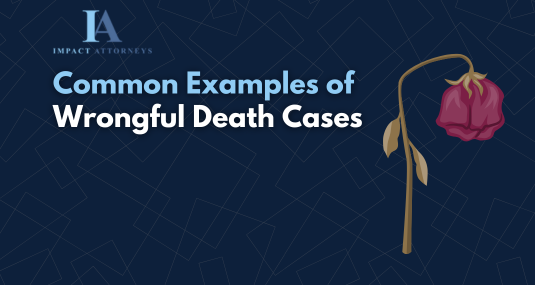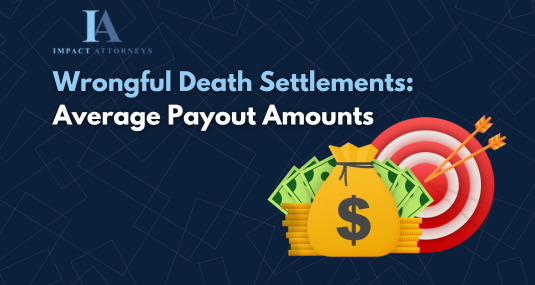Losing a loved one due to someone else’s negligence is devastating. At Impact Attorneys, we understand the emotional and financial toll this can take on families.
California’s wrongful death statute provides a legal avenue for seeking justice and compensation. However, it’s crucial to be aware of the CA wrongful death statute of limitations, which sets strict time limits for filing a claim.
What Is Wrongful Death in California?
Definition and Legal Concept
In California, a wrongful death occurs when an individual dies due to another party’s negligence or intentional harmful act. This legal concept allows surviving family members to seek compensation for their loss due to another party’s negligence or intentional actions. The law recognizes the profound impact of such deaths and provides a pathway for justice and financial recovery.
Eligible Parties for Filing a Claim
California law specifies who can file a wrongful death claim. Typically, this includes:
- Surviving spouse or domestic partner
- Children of the deceased
- Parents (if there are no surviving children)
- Siblings (if there are no surviving parents)
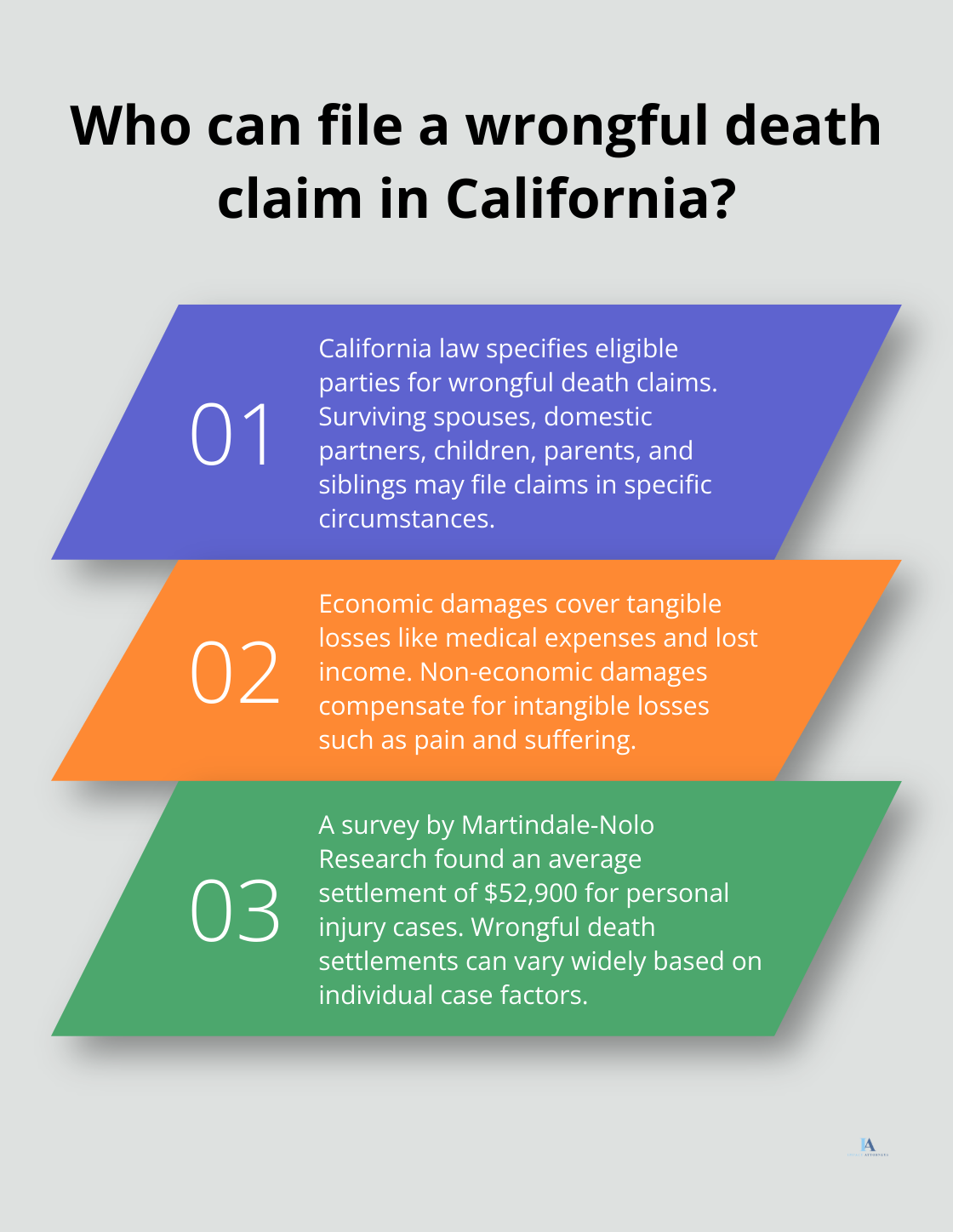
In some cases, other dependents or individuals who would inherit from the deceased may also file a claim. The specific circumstances of each case determine eligibility.
Types of Damages in Wrongful Death Cases
Wrongful death cases in California can result in various types of compensation:
- Economic damages: These cover tangible financial losses such as medical expenses, funeral costs, and lost future income.
- Non-economic damages: These compensate for intangible losses like pain and suffering, loss of companionship, and emotional distress. While harder to quantify, these damages often form a significant part of a wrongful death settlement.
- Punitive damages: In cases of extreme negligence or intentional harm, the court may award punitive damages to punish the wrongdoer and deter similar behavior.
The Importance of Proper Valuation
Accurately valuing a wrongful death claim is essential. A large survey by Martindale-Nolo Research found an average settlement amount of $52,900 for personal injury cases. However, each case is unique, and settlements can vary widely based on factors such as the deceased’s age, earning potential, and the circumstances of the death.
Economic experts play a vital role in ensuring all potential damages receive proper calculation and pursuit. This comprehensive approach helps maximize the compensation for clients, providing financial stability during a difficult time.
As we move forward, it’s important to understand the time limits for filing a wrongful death claim in California. These limitations can significantly impact your ability to seek justice and compensation for your loss.
When Must You File a Wrongful Death Claim?
The Standard Time Limit in California
California law sets a strict deadline for wrongful death claims. Families have two years from the date of death to file a lawsuit. This two-year period, known as the statute of limitations, starts on the day of death. If you miss this deadline, you’ll likely lose your right to seek compensation.
Exceptions to the Two-Year Rule
While the two-year limit applies in most cases, there are important exceptions:
- Government entities: You have only six months to file an administrative claim if a government agency is responsible. After that, you have six months from the claim’s rejection to file a lawsuit.
- Medical malpractice: These cases have a one-year limit from the date the injury was (or should have been) discovered, or three years from the date of injury, whichever comes first.
- Minor children: If the deceased’s heir is a minor, the statute may pause until they turn 18.
The Discovery Rule: Hidden Causes of Death
Sometimes, the cause of death isn’t immediately clear. In these cases, California’s discovery rule may apply. This rule states that the statute of limitations begins when the plaintiff discovers (or should have reasonably discovered) the cause of death.
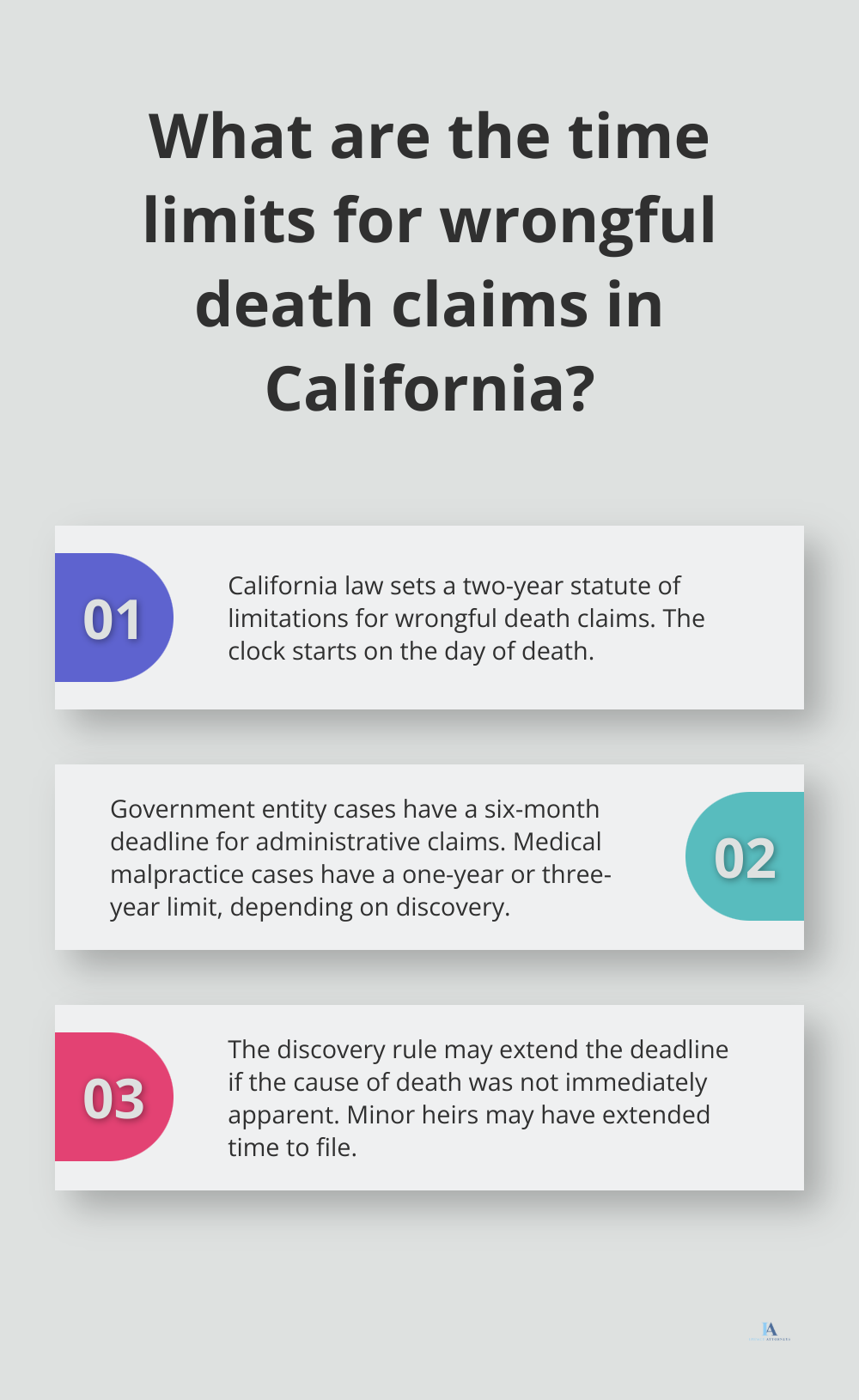
For example, if a person dies from a surgical error, but the family only learns about the mistake a year later, the two-year clock might start from the date of discovery, not the date of death.
To invoke the discovery rule, victims must demonstrate that they were unaware of the harm, the harm wasn’t discoverable, and reasonable efforts couldn’t have uncovered it earlier.
The Importance of Prompt Action
Acting quickly is essential for several reasons:
- Evidence preservation: Over time, evidence can disappear or degrade. Witness memories fade. The sooner you start your case, the stronger it can be.
- Financial relief: Wrongful death often brings unexpected expenses. The sooner you file, the sooner you might receive compensation.
- Peace of mind: Legal action can provide closure. Starting the process can be a step towards healing.
Don’t let time slip away. If you’ve lost a loved one due to someone else’s negligence, contact a qualified attorney immediately. At Impact Attorneys, we’re ready to guide you through this process, ensuring you don’t miss critical deadlines while fighting for the justice and compensation you deserve.
The next chapter will explore factors that can affect the statute of limitations in wrongful death cases, including special circumstances and legal complexities that may extend or shorten the filing deadline.
What Affects Wrongful Death Filing Deadlines?
The Discovery Rule: Unveiling Hidden Causes
California’s wrongful death statute of limitations isn’t always clear-cut. The discovery rule plays a significant role when the cause of death isn’t immediately apparent. This rule states that the statute of limitations begins when the plaintiff discovers (or should have reasonably discovered) the cause of death.
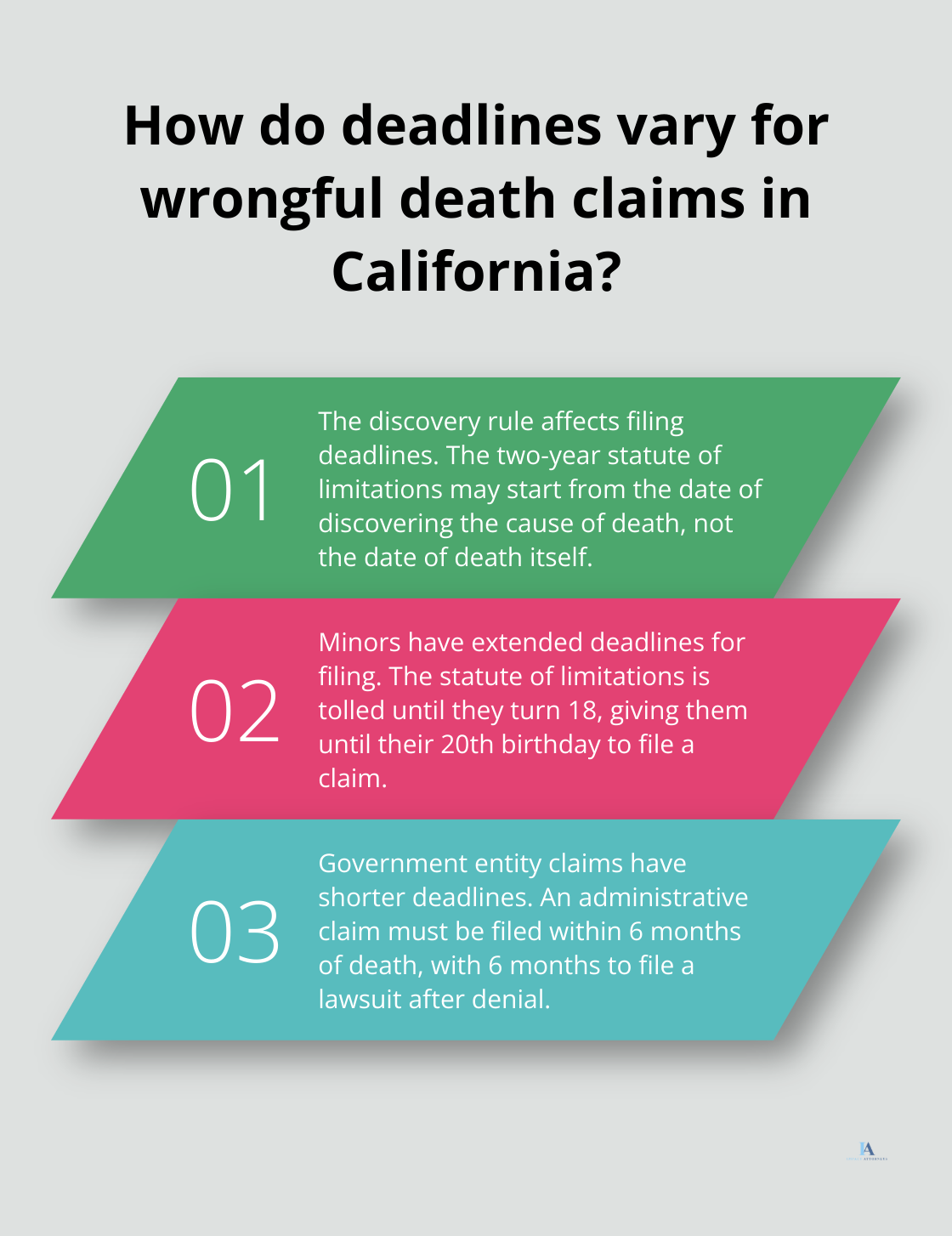
For instance, if a person dies from a surgical error, but the family learns about the mistake a year later, the two-year clock might start from the date of discovery, not the date of death. To invoke this rule, plaintiffs must prove that the cause wasn’t discoverable earlier through reasonable efforts.
Missing this deadline can result in losing the right to pursue compensation.
Minors and Statute Tolling
When the heir to a wrongful death claim is a minor, the statute of limitations may pause until they reach the age of majority. In California, this means the clock doesn’t start ticking until the child turns 18.
For example, if a 10-year-old loses a parent due to wrongful death, they would have until their 20th birthday to file a claim. This extension ensures that minors don’t lose their right to seek justice due to their age.
Government Entities: Accelerated Timelines
Claims against government entities have much shorter deadlines. In California, you must file an administrative claim within six months of the date of death. If the claim receives a denial, you then have six months from the denial date to file a lawsuit.
This accelerated timeline applies to various scenarios, from accidents involving city buses to negligence in public hospitals.
Complexities of Wrongful Death Claims
These complex rules and exceptions make navigating wrongful death claims challenging. Missing these deadlines can devastate families seeking justice. Experienced attorneys (like those at Impact Attorneys) understand how to handle these time-sensitive cases, ensuring that clients’ rights receive protection, regardless of the complexities involved.
Taking Action Within Time Limits
Understanding these factors is essential for families considering a wrongful death claim. To protect your rights and seek compensation for your loss, you should:
- Consult with an attorney as soon as possible after the death
- Gather all relevant documentation (medical records, police reports, etc.)
- Keep detailed notes about the circumstances surrounding the death
- Be prepared to act quickly, especially if government entities are involved
Final Thoughts
California’s wrongful death statute of limitations sets strict time limits for filing claims. The standard two-year deadline applies in most cases, but exceptions exist for government entities, medical malpractice, and cases involving minors. The discovery rule may extend the filing period when the cause of death isn’t immediately apparent.
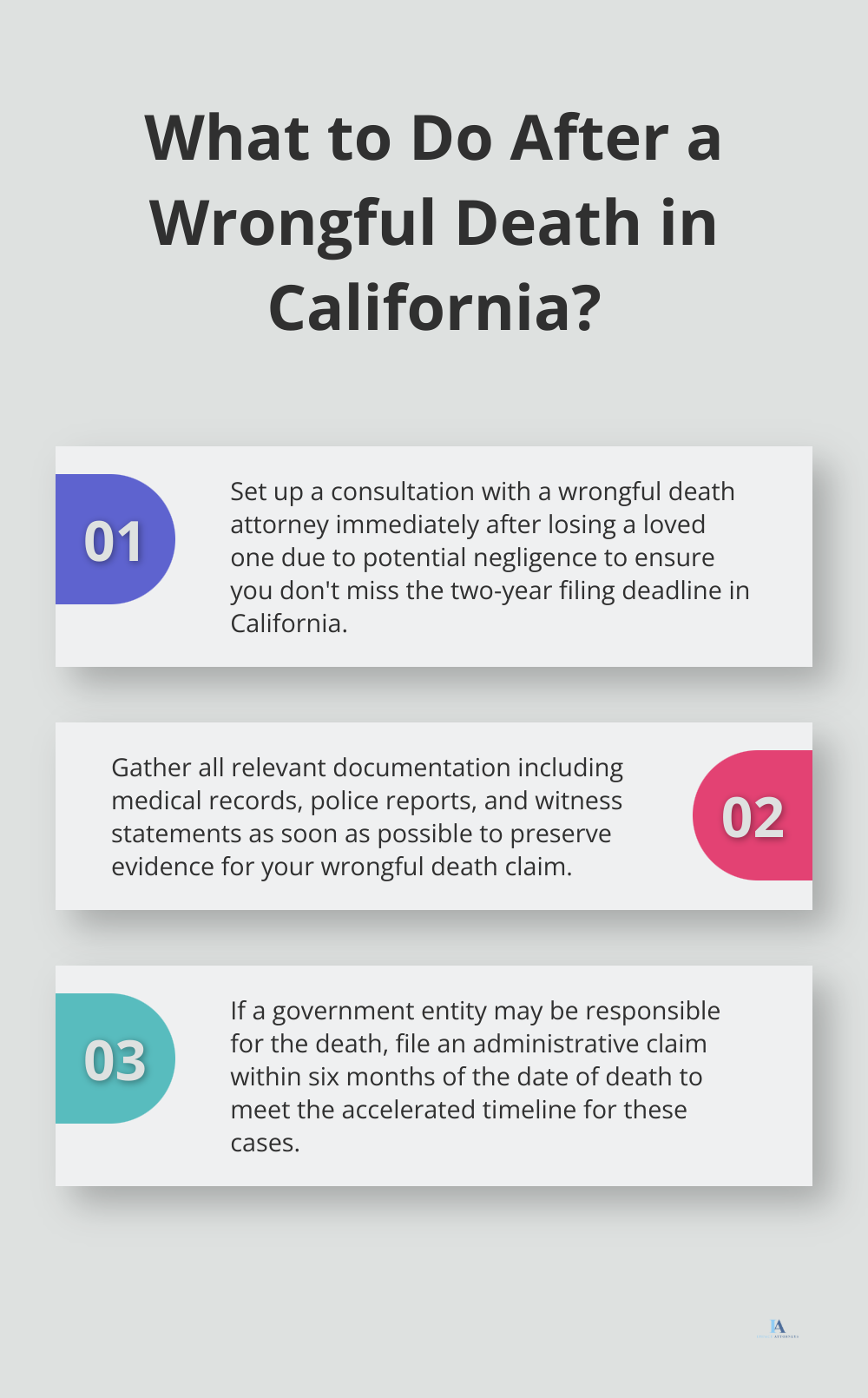
Understanding these complex timelines and exceptions protects your rights and helps pursue a successful claim. Missing these deadlines can result in the loss of your right to seek compensation, potentially leaving your family without financial support during this difficult time.
At Impact Attorneys, we specialize in personal injury law, including wrongful death cases. Our dedicated team understands the nuances of California’s wrongful death statute and can guide you through the legal process. Don’t let time slip away (if you’ve lost a loved one due to someone else’s negligence, reach out to us today).

